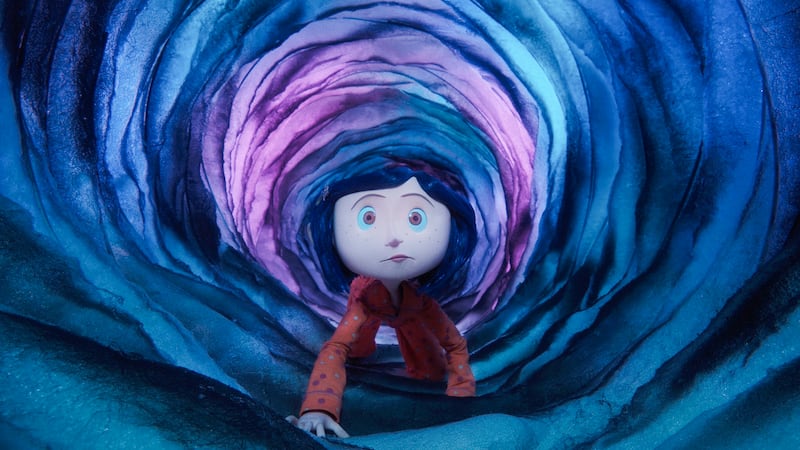Coraline isn’t the most narratively or technically complex movie to come out of Laika, the stop-motion animation studio based in Hillsboro (that’d be Kubo and the Two Strings or Missing Link). And it’ll never be the most iconic film from stop-motion visionary Henry Selick (that’s, inarguably, The Nightmare Before Christmas).
But 15 years after its release in February 2009, Coraline holds an impressive legacy. As Laika’s first feature, it launched a studio, reignited Selick’s career, and became one of the highest-grossing Oregon-made films ever ($124.6 million worldwide upon release, plus another $4.9 million over just two days of a 2023 rerelease).
Perhaps most importantly, from an artistic perspective, it remains a Mount Rushmore stop-motion film for the way the medium and the story intrinsically connect. Here, notions of world-building course through theme, text and character.
In Coraline, adapted from a novel by Neil Gaiman, our 11-year-old protagonist moves from Pontiac, Mich., to Ashland, Ore., with her work-distracted parents. Their new house is a musty, yet striking pink Victorian, cordoned into apartments and set against a cloudy, coniferous hillside. Coraline (voiced by Dakota Fanning) is eager to explore her new confines, but the parents (voiced by Teri Hatcher and John Hodgman) are hunched over their computers authoring a new garden catalog and don’t want mud in the house.
Left to her own devices, Coraline soon discovers a crawl space leading to a mystical parallel version of the house. Down this rabbit hole reside her “other parents”: boredom-averse, idealized versions of Mom and Dad, who prepare feasts and dedicate beautiful gardens to their daughter instead of writing about other people’s flower beds. And if they happen to have black buttons for eyes and want her to live with them forever and ever, so what…not that worrisome, right?
As this parallel-universe ghost story unfolds, one of stop-motion animation’s most famous axioms rings clear as a bell: Someone molded, printed or puppeted every single thing that appears in each frame. Only in Coraline’s case, half the fun is watching Selick and his 35 animators create Coraline’s first world…and then do it again, riffing on everything you saw through the prism of Coraline’s desire for more doting parents and a more vibrant home.
Granted, the plots of Henry Selick films have always traded in realm-crossing. The Nightmare Before Christmas, James and the Giant Peach, Monkeybone, Wendell and Wild, even Selick’s unceremoniously scuttled The Shadow King all explicitly concern characters entering alternative worlds.
Still, that theme has never felt so character-driven or focused as in Coraline. The Laika crew crafted not only parallel universes but the creative currents peeking out from beneath those worlds. Ashland is more interesting than it appears. The other world, more insidious.
Southern Oregon as imagined in Coraline is drab, muck-green, almost painted over in fog. But out of this haze rises a sense of gothic mystery: Coraline’s neighbor Wybie in a skeleton mask careening down the hillside on his dirt bike, neighbors squirreled away with their eccentric obsessions, black cats disappearing into rotted-out tree trunks.
By contrast, “the other world” is a jazzy buffet of pleasures—birthday cakes, the warm reds of Other Mother’s lipstick and Other Dad’s smoking jacket, a surreal gardening scene featuring hundreds of painstakingly handcrafted flowers, designed at Laika to both grow and illuminate.
Because this alluring atmosphere is designed with Coraline’s temptation in mind, the filmmakers get to savor a deconstructionist tendency and show both how Other Mother created this spread and also the cracks in its façade. Take, for example, how this fabricated reality falls away into blank white space when Coraline wanders from her house. Stop-motion, as always, is unrivaled when it comes to showing one’s work.
Now, just because the story’s design is defined by internal logic as opposed to the cross-continental sweep of a movie like Missing Link or the narrative frenzy of Wendell and Wild doesn’t mean anyone took it easy.
Coraline employed first-of-the-kind technologies still vital to modern stop-motion. It was the first stop-motion movie to be filmed in stereoscopic 3D—a relevant benchmark given that a remastered 3D version of Coraline will hit theaters this August.
The 2009 film also marked the first time puppet facial expressions could be 3D-printed, which massively expanded the range of possible emotions characters could display. Our heroine had 6,300 interchangeable faces all her own.
Is it possible Coraline’s wider, more lifelike eyes drew audiences to the character in both 2009 and today? Hard to say, but her no-bullshit sense of adventure certainly couldn’t have hurt. In 2013, lead animator and Laika CEO Travis Knight told Entertainment Weekly that prospective Coraline financiers expressed concerns that boys would not relate to Coraline and girls would reject the movie’s horror elements.
Turns out very few imaginative children could reject the kind of protagonist who smashes home-invading centipedes with the same swollen palm that already has poison-oak rash from that morning’s outdoor explorations. Even if Coraline doesn’t appear to have the cheek dexterity of higher-tech puppets in later Laika films, she’s a vital presence.
In all, Coraline achieved something that Laika (or any studio making entertainment geared toward children) is still chasing—to create a character that captures audiences well enough to bring them back 15 years later.
In this way, Coraline lives at an intersection at which Hollywood movies have aspired to land since The Wizard of Oz—the sweet spot where technology, art and entertainment meet in popular alchemy.
